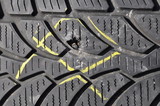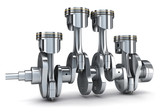
Under the Bonnet and Tyre Checks
As part of your driving test you will be asked to explain how you would perform under the bonnet technical checks for oil, coolant, windscreen washer fluid and brake fluid. You will be asked to open the bonnet and show where you would check for each. You will not have to physically perform these technical checks just show the location of each safety reservoir cap and describe how you would check the fluid level for each. Please make sure you can open and close the bonnet confidently as this gives a first good impression. Don’t push down on the bonnet as you may dent it. Just drop the bonnet from a height of about half a meter to close.
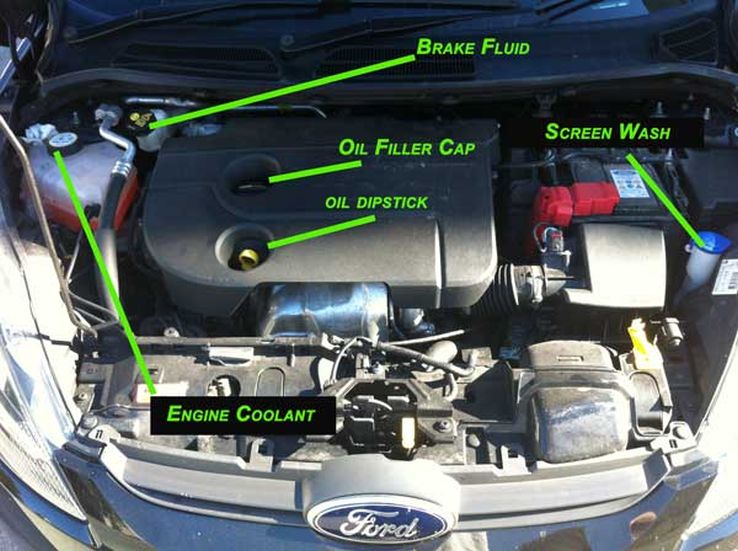
The photograph shows the location of brake fluid, oil dips stick, oil filler cap, engine coolant and windscreen washer. This picture gives you a general impression of what to look for in your car. Consult your vehicles manual or ask your ADI to locate the necessary items listed below for your driving test.
Be aware it is false economy not to proceed with your vehicle checks which are:
- Daily
- Weekly
- Service
- Seasonally
It could cost you a lot more in the long run. Maybe even your life and your passengers lives.
Car Daily Checks
To see and be seen: make sure windows and mirrors are kept clean. Light should be checked every day including brake lights. Clean your reflectors if needed. Also, quick visual check of your tyres for any cuts or bulges caused by kerb contact.
Car Weekly Checks
Most of these items should normally be checked visually on a weekly basis and should be built into your own weekly preventive maintenance safety routine on your car. These weekly checks mostly consist of checking your water and lubricant levels. Get to know them; do not leave it to your next car service as serious damage can occur to your engine if some levels are too low. An example would be low engine oil.
Engine Coolant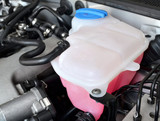
Checking engine coolant, indicate the position of the coolant reservoir and tell your driving tester you would check between the minimum and maximum levels to ensure the engine has enough coolant.
Warning: never remove coolant cap just after driving as high pressure can cause scalding. Wait until engine has cooled down before adding coolant.
Brake Fluid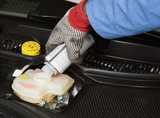
This fluid is vital to your braking system. Indicate the position of the brake fluid reservoir and tell your driving tester you would check between the minimum and maximum levels to ensure the braking system has enough brake fluid.
Engine Oil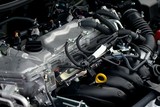
Checking engine oil, with car on level ground and the engine cool, pull out the dipstick, and wipe the end clean. Put the dipstick back into its hole, take it out again, making sure the level of oil is between the upper and lower marks on the dipstick. 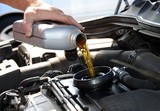
If asked if engine oil was low by your driving tester, you would indicate the position the oil cap, remove it and top up oil to acceptable level. If the oil level is near the low mark, a litre of oil may be needed to top up to the high mark. Do not fill beyond the high mark as this can cause engine damage.
Power Steering Fluid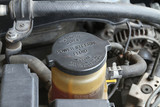
Checking Power steering, indicate the position of the power fluid reservoir and tell your driving tester you would check between the minimum and maximum levels to ensure the steering system has enough fluid. On some vehicle models this reservoir can be hard to access and you may need to bring it to your mechanic.
Windscreen Washer Fluid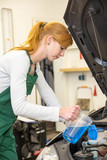
When asked where and how to refill the water for the windscreen washer. Indicate the windscreen washer fluid reservoir and tell your driving tester you would fill it the max level with the correct mixture of good quality windscreen wash liquid and water. Cleaning the wiper blades will prevent scratching of the windscreen from grit build up.
Tyre Grip Safety Checks
All that’s between you and the almighty is your tyre grip. The actual area of contact 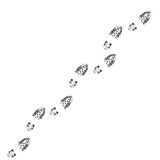 between your tyre and the road is about the same as the sole of your shoe. So, tyres are the vital key to your safety on the road. Losing your life over a few inches of rubber is just crazy. It is absolutely essential you visually check your tyres at least once a week for the following faults which affect tyre grip.
between your tyre and the road is about the same as the sole of your shoe. So, tyres are the vital key to your safety on the road. Losing your life over a few inches of rubber is just crazy. It is absolutely essential you visually check your tyres at least once a week for the following faults which affect tyre grip.
Usually due to vehicle mounting kerb excessively, look for any lump or bulge on the tyre indicating tyre breakdown. Also look for stones caught in between the threads of your tyres, pry them out before they do any damage. Click on image above for great infromation on tyre care.
Tyre Pressure Faults
Because of the dangers of over-inflation and under – inflation you must learn how to use the air pump correctly and inflate your tyres to the right pressure. If you must get someone at the garage to teach you correctly then do so.
The information for the correct tyre pressure can be found either:
- On the door frame of the drivers car stamped on an aluminum plate.
- The inside of the small door flap which allows access to the petrol cap
· The manufacturer’s manual
Remember there are different tyre pressures for different loads so note these and be aware of the need to change tyre pressure when the car is fully loaded I.E. Extra luggage while going on holiday. Inflate your tyres when they are cold as there is a relationship between pressure and heat which will give you a false reading.
-
Under –Inflation
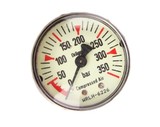
Tyres inflated below correct operating pressure. Look for excessive wear on the outer threads of the tyre.
-
Over- Inflation
Tyres inflated beyond correct operating pressure. Look for excessive wear along the centre of the tyre.
Remember Incorrect Tyre Pressure
- Results in shorter tyre life
- May create a danger a it can affect stability and braking capacity
- Under inflation can increase fuel consumption and emissions
Top Tip
When replacing tyres consider buying energy saving types: which have reduced rolling resistance. They increase fuel efficiency and also improve your grip on the road and reduce your braking distance. Ask your dealer: Michelin.co.uk have more information.
Incorrect wheel alignment
Bad wheel alignment due to incorrect tracking will cause feathering either on the inner or outer edge of your tyres. Get corrected ASAP as tyres will wear much quicker than they normally should.
Spot Wear
Unbalanced tyres will wear quickly; this can be identified by uneven wear on the tyre. May also be caused by worn suspension or steering. Correct at garage.
Top Tips and Advice
· Legally your tyres should have a thread depth of 1.6mm but in the winter replace them at 4mm for increased safety to deal with the following road hazards:
- Aquaplaning

- Snow
- Ice
- Black ice
- Potholes after frost
Advice
The importance of tyre grip cannot be underestimated. It’s worth remembering:
- It’s only these few millimeters of rubber which grip the road.
- As already mentioned the amount of contact the average tyre has with the road is the roughly the same as the sole of your shoe.
- This could be the difference between life and death.

Do
- Purchase a tread depth gauge and weekly check the tread depth.
- You should be able to wedge your finders between the treads of your tyres.
- Check your thread wear indicator weekly. Arrow on tyre to show indicator if the treads are worn down to the level of the indicator change the tyre.
· Don’t lose your life over a few millimeters of rubber.
Please respect your tyres they are all you have got on the road. Please do not dry steer or bump the kerb.
Service Checks
Consult manufacture’s manual. Get yourself a copy of the AA car Duffers Guide for handy advice.
Seasonal Checks
As winter approaches get your antifreeze checked for strength. Normally will last for about two years, flushing the cooling system of old antifreeze before new is always a good idea. In the springtime get the underneath of vehicle power hosed to remove grit and salt which may have build up.
If you found any of the above information useful please share it by clicking on your favourite social media platfrom. We would really appreciate it, thank you.

